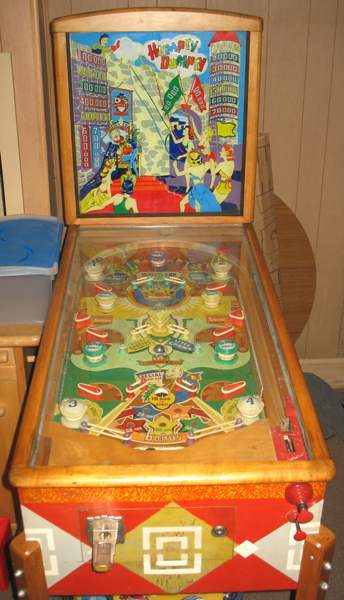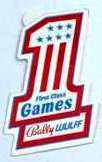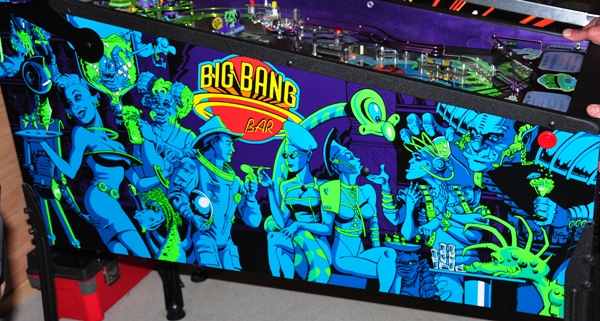History of the most important American pinball manufacturers
This article isn’t about the history of pinball itself. Plenty of websites explain how the French game Bagatelle evolved, and how score counters, bumpers, and flippers were added until it became what we now call a pinball machine. Here, we’ll focus on the largest and most influential American companies that manufactured pinball machines. Almost all have long and intertwined histories.
Gottlieb was founded in 1927 by David Gottlieb, Williams in 1946 by Harry Williams, and Bally in 1932 by Ray Moloney. Takeovers, bankruptcies, name changes, and mergers make the history of one company blend with another. Subsidiaries became independent and sometimes grew large enough to acquire their former parent companies.
Notably, only a limited number of people or families were involved with most of these companies. Unlike other articles that group history by company, I’ve chosen to organize events by family or individual.
Gottlieb

D. Gottlieb logo.
The Gottlieb company remained a family business for 50 years, from its founding in 1927 until it was sold to Columbia Pictures in 1977. They helped define the modern pinball machine. In the early years, they produced mechanical games like Baffle Ball. In 1935, they began making electric games, and in 1947, they introduced flipper bats with Humpty Dumpty: the birth of the true pinball machine.

Gottlieb Humpty Dumpty - the first pintable with flippers. Photo by Gregory Johnson.
After becoming a Columbia Pictures subsidiary in 1977, Gottlieb produced many movie-themed machines like Pink Panther, Spiderman, and James Bond. They also made arcade games, including the popular Q*Bert, which was even adapted into a pinball machine: Q*Bert's Quest.
Columbia Pictures was later acquired by Coca-Cola, and in 1983, Gottlieb was renamed Mylstar. In 1984, Coca-Cola planned to shut it down, but a management buyout led to the creation of Premier Technology, run by Gilbert Pollock and the Fesjian family (owners of Mondial, a major pinball distributor). Premier continued producing pinball machines under the Gottlieb name until July 1996. Their final game was Barb Wire. Mondial Group still owns the rights to Gottlieb pinball machines.
Pinball remained in the Gottlieb family’s blood. In 1992, David Gottlieb’s son Alvin and grandson Michael started the company Alvin G to create pinball machines. They couldn’t use the Gottlieb name as it was still licensed to Premier, so they used the 'G.' They produced a limited number of games before closing in 1994.
Roy Moloney

Bally logo
Roy Moloney didn’t begin as a manufacturer, he was a skilled salesman who sold amusement games from other companies. When Gottlieb couldn’t meet his demand, he began producing his own affordable games, starting with Ballyhoo, named after a popular magazine. The game’s artwork was inspired by the magazine as well.

Eventually, Roy founded Bally, named after the game that brought him success. He ran the company until his death in 1958. In 1963, a group of investors took over. Over the years, Bally acquired several companies, including Midway and the German firm Wulff.
By the 1980s, Bally expanded into casinos, amusement parks (like Six Flags), and fitness clubs. Due to financial strain from acquisitions, Bally sold Midway and its pinball division to Williams in 1988. The Bally holding company still exists but no longer produces amusement games.
Harry Williams and the Stern family
Harry Williams worked in the 1930s for Bally and Rock-Ola. In 1946, he founded Williams Manufacturing Company. Sam Stern joined as Vice President in 1949 and eventually acquired Harry’s share around 1960.
Harry didn’t retire quietly. In the 1960s, he founded Southland Engineering, which created the mini-golf game Little Pro. Williams later bought and released it as a two-player game. Harry continued designing pinball playfields, even for Stern Electronics, until his death.
In 1964, jukebox maker Seeburg acquired Williams and United. Sam Stern oversaw both subsidiaries. Their activities were nicely divided. Williams focused on pinball and arcade games, while United specialized in bowling and shuffle machines. The Seeburg Corporation group even ventured into musical instruments.
Sam Stern left Williams in 1976 and founded Stern Electronics Inc. He acquired assets from Chicago Coin, which had defaulted, and Universal Research Laboratories (URL), a small firm of ex-Seeburg engineers who developed electronic PCBs.
Chicago Coin, founded in the 1930s, was similar to Gottlieb. It was a family-owned business run by the Ginsburg and Wohlberg families. They had acquired Genco in the 1950s. Genco was a smaller company that also had produced some pinball machines. Sam ran Stern Electronics with his son Gary, who had started at Williams in 1973. Stern produced pinball machines, jukeboxes, and video games like Berzerk. In their late years they even took over the division of Seeburg that produced jukeboxes, after that group defaulted. Their final pinball machine was Orbitor One in 1982. The company closed in 1984.

Sterns Orbitor One pinball machine is the only one to feature both the Stern and Seeburg logo on its backglass.
Gary Stern later founded Pinstar, which made conversion kits for Bally machines. Conversion kits are a new backglass an playfield, that operators could install into the cabinet of another Bally pinball machine. These weren’t successful due to the rise of alphanumeric pinball machines.
In 1986, Gary partnered with Data East to form Data East Pinball. Many ex-Pinstar and ex-Stern employees joined. Sega acquired the company in 1993, renaming it Sega Pinball. At the end of 1999, Sega decided to retire in the pinball manufacturing business as game sales were declining year after year. Gary Stern himself took over the company which again changed its name, now into Stern Pinball Inc.
Here is what Gary Stern told me about this time:
I worked at Williams in most summers from time I was 16 in 1961. In that year I starting working in the stockroom,
and over the subsequent years I worked in all departments.
Although Harry Willams has sold his ownership in to Sam many years before, he always worked with us.
Further than working with us, he was near a 2nd father to me.
In 1964 Sam sold Williams to Seeburg. He remained at Williams as president until he retired, except for a 1 year stint as EVP of Bally.
When I graduated law school in January 1971, I went to work for a La Salle Street law firm, which was a corporate and business bankruptcy firm.
In 1973 I left the practice of law and joined Williams full time. Sam was President.
In 1976, we left Williams and Sam retired. I bought and sold slot machines, including from Williams.
Chicago Dynamic Industries, Inc. dba Chicago Coin was owned by the Ginsburg and Wohlberg families.
In 1976 that company was in default on its bank loans. The bank foreclosed, resulting in the bank's acquisition of all the CDI assets,
including its factory. Investors including my brother and myself formed Stern Electronics, Inc., which purchased all these assets
that formerly belonged to CDI. Sam worked there part time as vice president, but certainly was a moving force.
My brother continued in his practice of medicine. I operated the company as president.
Harry passed away in the early 1980's. Sam passed away after a long illness in 1984.
We operated the company until later 1984. The game business significantly changed and we closed Stern Electronics.
[Most people think Stern Pinball is a continuation of Stern Electronics].
Among my activities in the next few years was the design, manufacture and sale at Pinstar of the Gametron conversion kit for Bally pinball machines.
In 1986 I interested Data East in an investment to create a new pinball company, and Data East Pinball, Inc. was formed.
In 1994 we sold Data East Pinball to Sega, and we changed its name to Sega Pinball, Inc.
In 1999, my group bought Sega Pinball, and we changed its name again to Stern Pinball, Inc.
Nicastro family and Williams
Back in the 1970s, the Seeburg group faced financial trouble. Under Louis Nicastro’s leadership, the group became independent from their parent conglomerate and split further. The pinball department, a flourishing subsidiary, became an independent company Williams Electronics, after Seeburg’s bankruptcy in 1979.
During the 1980s, Williams emerged as the industry leader in pinball manufacturing, following Bally’s dominance in the 1970s and Gottlieb’s in the 1950s and 1960s. The pinball division was renamed Williams Electronic Gaming, and the holding company became Williams Industries.
In 1988, Williams acquired Bally Midway Manufacturing Company, which produced both pinball and arcade games. As part of the deal, Williams received the rights to use the Bally name and logo for amusement devices. From then on, machines were sold under either the Bally or Williams brand, but all were produced in the same factory.
In 1991, Williams Gaming was founded as a subsidiary focused on gambling machines. Revenues soared, and in October 1999, the management team led by Neil Nicastro (Louis’s son) decided to shut down the pinball division. Despite the success of Pinball 2000, the division’s revenue lagged behind other departments.
The intellectual property rights for Williams pinball machines and parts were later sold to Illinois Pinball and The Pinball Factory/Mr. Pinball Australia. These were eventually acquired by Planetary Pinball.
Atari and Capcom
Atari and Capcom are exceptions in this history. Neither was family-owned, and neither had a long legacy in amusement games. Atari produced pinball machines from 1976 to 1983. Capcom’s pinball division, GameStar, operated from 1994 to 1996.
In mid-1996, Sega and Capcom explored a merger of their pinball departments, but it never materialized. Capcom Pinball closed later that year. In 2000, Illinois Pin Ball acquired the rights and parts from Capcom.

Big Bang Bar pinball machine by Illinois Pin Ball.
Gene Cunningham of Illinois Pin Ball
Gene Cunningham was a passionate pinball collector and entrepreneur based in Bloomington, Illinois. His pinball journey began when he acquired a pinball machine from his skating rink. That single game sparked a lifelong obsession, eventually growing into a personal collection of over 1000 machines, along with jukeboxes and antique slot machines.
When Williams Electronics exited the pinball market in 1999, Cunningham purchased their stock of spare parts and associated rights. He also acquired the rights of Capcom pinball. His company to manage this was Illinois Pin Ball Inc. (IPB).
One of his most ambitious projects was the long-awaited remake of Big Bang Bar, originally developed by Capcom in 1996. Despite delays and production challenges, IPB eventually released 191 units under the name Pinball Manufacturing Inc., a division of Illinois Pin Ball.
Jack Guarnieri of Jersey Jack Pinball
Guarnieri had been involved in the industry since 1975, initially servicing electromechanical machines, and later launching PinballSales.com in 1999. His deep-rooted passion for the game laid the foundation for a company that would challenge the status quo. With his background in sales, one could compare him to Roy Monoley.
In the early 2000s, Guarnieri became increasingly vocal about the need for higher-quality, limited-edition machines that catered to collectors and serious enthusiasts, not just arcade operators. As lone surviver in the pinball manufacturing business, Sterns target group was amusement machine operators. The amount of pinball collectors that bought a new in box game was very limited, but that was the group Jack catered to. Because of Jacks feedback, Stern did produce a few limited edition runs, such as the Platinum edition of Monopoly, limited to 40 machines. However, Stern’s focus remained on mass-market appeal and cost-effective production, leaving little room for the kind of innovation Guarnieri envisioned.
Frustrated by the lack of response, Guarnieri decided to take matters into his own hands. In 2011, he launched Jersey Jack Pinball with the goal of revolutionizing the industry. His first title, The Wizard of Oz, was a bold statement: a wide-body machine packed with RGB LEDs, a 26-inch HD LCD screen, and a rich, cinematic experience that had never been seen in pinball before. It was everything he had wanted Stern to build, and more.
If you're looking for pinball parts, then check out Pinballshop.nl (affiliate link).
